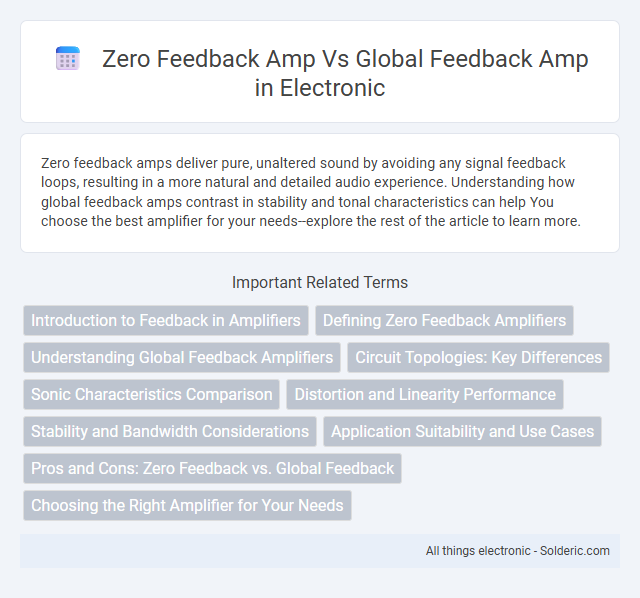Zero feedback amps deliver pure, unaltered sound by avoiding any signal feedback loops, resulting in a more natural and detailed audio experience. Understanding how global feedback amps contrast in stability and tonal characteristics can help You choose the best amplifier for your needs--explore the rest of the article to learn more.
Comparison Table
| Feature | Zero Feedback Amplifier | Global Feedback Amplifier |
|---|---|---|
| Definition | Amplifier without any feedback loop applied to the signal | Amplifier uses a global feedback loop from output to input |
| Distortion | Higher harmonic distortion due to no correction mechanism | Lower distortion from feedback-based error correction |
| Gain Stability | Less stable, gain varies with temperature and transistor parameters | More stable, feedback stabilizes gain performance |
| Bandwidth | Usually higher bandwidth without feedback limitations | Reduced bandwidth due to feedback loop effects |
| Noise Performance | Potentially lower noise as no feedback noise introduced | Feedback can increase or reduce noise depending on design |
| Complexity | Simpler circuit design, fewer components | More complex design with additional feedback network |
| Examples | High-fidelity tube amplifiers, Class A amps without feedback | Most modern solid-state audio amplifiers |
Introduction to Feedback in Amplifiers
Feedback in amplifiers controls gain stability and distortion by routing a portion of the output signal back to the input. Zero feedback amplifiers operate without this loop, often delivering a purer signal with minimal phase shift but potentially less stability. Your choice between zero feedback amp and global feedback amp depends on the desired trade-off between sonic transparency and precise gain control.
Defining Zero Feedback Amplifiers
Zero feedback amplifiers operate without negative feedback loops, relying on their intrinsic design to maintain signal fidelity and stability. Unlike global feedback amps that use an overall feedback path to reduce distortion and improve linearity, zero feedback designs emphasize minimal signal alteration for a more natural sound reproduction. Your choice between these types impacts audio accuracy and amplifier complexity, making zero feedback amps preferred in audiophile settings for their transparency.
Understanding Global Feedback Amplifiers
Global feedback amplifiers utilize a feedback loop that samples the output signal and feeds it back to the input, enhancing linearity and reducing distortion across the entire amplifier. This comprehensive feedback mechanism improves bandwidth and stability by correcting errors in the output stage, resulting in more accurate amplification compared to zero feedback amplifiers. Zero feedback amplifiers lack this corrective loop, often exhibiting higher distortion and less predictable frequency response due to the absence of error correction.
Circuit Topologies: Key Differences
Zero feedback amplifiers use a simple circuit topology that avoids negative feedback loops, relying on the inherent linearity of the active devices to achieve amplification. Global feedback amplifiers incorporate a feedback loop from the output back to the input, stabilizing gain and reducing distortion but adding complexity to the circuit design. Understanding these key differences in circuit topologies helps you choose the right amplifier type for applications requiring purity of sound versus stability and precision.
Sonic Characteristics Comparison
Zero feedback amplifiers deliver a more natural and dynamic sonic experience by preserving the raw, unprocessed audio signal, resulting in greater transparency and warmth. Global feedback amplifiers offer improved distortion reduction and frequency response linearity but can introduce a slight loss of musical nuance and subtle harmonic complexity. Audiophiles often prefer zero feedback designs for their richer midrange and organic soundstage, while global feedback amps excel in precision and control.
Distortion and Linearity Performance
Zero feedback amplifiers typically exhibit higher distortion levels due to the lack of corrective feedback mechanisms, resulting in less accurate linearity performance. Global feedback amplifiers employ feedback loops that significantly reduce harmonic and intermodulation distortion, enhancing overall linearity and fidelity. Your choice depends on whether you prioritize the natural sound characteristics of zero feedback designs or the precise, low-distortion response of global feedback amps.
Stability and Bandwidth Considerations
Zero feedback amplifiers inherently offer superior stability by eliminating phase shifts caused by feedback loops, which can induce oscillations. However, this design typically results in limited bandwidth due to reliance on the amplifier's intrinsic gain-bandwidth product. Global feedback amplifiers extend bandwidth by reducing gain at high frequencies through negative feedback while improving linearity but require compensation techniques to maintain stability and prevent high-frequency oscillations.
Application Suitability and Use Cases
Zero feedback amplifiers excel in high-fidelity audio applications where minimal distortion and natural sound reproduction are critical, making them ideal for audiophile-grade equipment and specialized measurement tools. Global feedback amplifiers suit diverse general-purpose audio and instrumentation tasks by offering improved linearity, reduced distortion, and enhanced stability over a wide frequency range. Your choice depends on whether priority is given to sonic purity or operational versatility in the intended application.
Pros and Cons: Zero Feedback vs. Global Feedback
Zero feedback amps offer superior signal purity and minimal distortion by avoiding the use of global feedback loops, resulting in a more natural and dynamic sound quality often favored by audiophiles. However, they usually exhibit higher harmonic distortion and less precise control over frequency response compared to global feedback amps, which utilize negative feedback to reduce distortion and improve efficiency and stability. Your choice depends on whether you prioritize sonic transparency and warmth (zero feedback) or improved linearity and performance consistency (global feedback).
Choosing the Right Amplifier for Your Needs
Zero feedback amplifiers provide a pure, uncolored sound by eliminating negative feedback loops, making them ideal for audiophiles seeking natural audio reproduction. Global feedback amplifiers offer greater stability and reduced distortion, improving overall performance and efficiency, suitable for versatile applications and everyday listening. Selecting the right amplifier depends on prioritizing sound purity versus consistency, with zero feedback preferred for high-fidelity audio and global feedback favored for reliability and controlled distortion.
Zero feedback amp vs Global feedback amp Infographic

 solderic.com
solderic.com